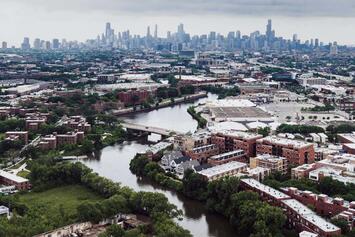
I’ll state this right from the outset. This is not a take-down. I’m expressing a point of view that differs from conventional urbanism wisdom. Please keep that in my mind as you read on.
Back in 2014, I wrote an article for my earlier blog entitled Two Chicagos, Defined. In the article, I described Chicago’s troubling expansion of inequality at many different levels – income, educational attainment, employment, housing costs, crime, transit access, job access, and so much more. I found that the gap was widening, at the metro level (where I focused my initial analysis) and at the city level as well. In the end, I found three distinct Chicagos that were worth noting: 1) a growing “Super Global” Chicago concentrated in the city’s downtown, north lakefront and near south lakefront neighborhoods that was affluent, highly educated and largely white; 2) an “Average Chicago” that was less affluent, less highly educated, containing more people of color and experiencing a sense of instability; and 3) a “Rust Belt Chicago” that was significantly lagging the other two segments on every level. I concluded that article with this statement:
“In reality I see the "Two Chicagos" meme as overplayed. Chicago may be better understood in thirds -- one-third San Francisco, two-thirds Detroit.”
At the time, that statement caused a huge reaction on Twitter, positively and negatively. There were many supportive reactions from people who seemed to understand that Chicago’s deep divides were widening and hardening, and got the general point that the city needed to be more beneficial to more of its residents. Some of the reactions were visceral; many Chicagoans could not fathom a comparison of Chicago with Detroit, a city understood by many to be well below Chicago’s stature. In fact, friend and fellow Substack writer Aaron Renn told me that the quote had reached former Chicago Mayor Rahm Emanuel and was discussed during an interview he had with him. He hated it.
But that underscores a misunderstanding about both Chicago and Detroit. Detroit is not the completely collapsed urban dystopia that many imagine it to be; there is a rapidly revitalizing downtown, and great neighborhoods that are getting stronger. However, there is poverty and crime, and neighborhoods that sit on an uncertain precipice. Similarly, Chicago is more than its beautiful skyline, fantastic lakefront neighborhoods and the strong post-industrial economy that supports that part of the city’s growth. Chicago is also the city well known for its legacy of government patronage and political corruption, and reviled for its own high violent crime.
What’s this got to do with anything, you say?
Well, on Wednesday, Yonah Freemark of the nonprofit thinktank Urban Institute commented on the Institute's Urban Wire blog that zoning restrictions and the nature of housing demand in Chicago has split the city in three – an affluent, high-demand central area and lakefront with lots of housing construction, an affluent and middle class, high-demand North and Northwest Side with little housing construction, and a low-income, low-demand West, Southwest and West sides that’s actually losing housing units and people.
Read the rest of this piece at The Corner Side Yard.
Pete Saunders is a writer and researcher whose work focuses on urbanism and public policy. Pete has been the editor/publisher of the Corner Side Yard, an urbanist blog, since 2012. Pete is also an urban affairs contributor to Forbes Magazine's online platform. Pete's writings have been published widely in traditional and internet media outlets, including the feature article in the December 2018 issue of Planning Magazine. Pete has more than twenty years' experience in planning, economic development, and community development, with stops in the public, private and non-profit sectors. He lives in Chicago.
Photo: Kelly Lacy, via Pexels in Public Domain.












